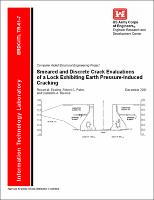Please use this identifier to cite or link to this item:
https://hdl.handle.net/11681/10865| Title: | Smeared and discrete crack evaluations of a lock exhibiting earth pressure-induced cracking |
| Authors: | United States. Army. Corps of Engineers. New England District Computer-Aided Structural Engineering Project (U.S.) Ebeling, Robert M., 1954- Patev, Robert C. Riveros, Guillermo A. |
| Keywords: | Aging of concrete Cracking Hydraulic concrete structure NISA At-rest earth pressures Discrete crack LEFM Smeared crack Compaction-induced earth pressures Fracture mechanics Massive concrete lock wall Thermal stresses Saint Lawrence Seaway Snell Lock |
| Publisher: | Information Technology Laboratory (U.S.) Engineer Research and Development Center (U.S.) |
| Series/Report no.: | ERDC/ITL TR 01-7. |
| Description: | Technical Report Abstract: This report discusses the results of an evaluation of crack initiation and propagation at Snell Lock, one of the locks constructed on the St. Lawrence Seaway during 1956 and 1957. The rock-founded, unreinforced concrete gravity lock walls of Snell Lock experienced cracking as a result of earth loading in excess of those anticipated during structural design. The objective of this study is to appraise two analytical procedures used to evaluate the potential for and/or the extent of cracking within massive concrete structures. The two analytical procedures available for analyzing hydraulic structures that may exhibit cracking during loading are based on either the smeared crack theory or the discrete crack theory. The smeared crack theory uses a strength-of-materials approach to evaluate crack initiation potential and/or crack propagation in a material. A linear elastic fracture mechanics (LEFM) discrete crack analysis is used to assess if a discrete crack will propagate or arrest for a given increment of loading. Generally, LEFM relate the stress magnitude and distribution at the crack tip to the nominal stress applied to the structure; to the size, shape, and orientation of the crack or discontinuity; and to the material properties. The demand due to loading(s) applied to the retaining structure and specifically to the region of cracking is represented by stress intensity factors. The capacity of the material is characterized by the fracture toughness. Cracking potential and crack extent for Snell Lock are assessed for both short-term, end-of-construction earth loading and long-term earth and water loading. A finite element thermal analysis (a nonlinear incremental structural analysis (NISA) based on smeared crack theory) performed on Snell Lock Monolith N-56 gives the strong indication that the potential for cracking in the upper right corner of the lower monolith did exist after the backfilling was complete in 1957 (referred to as end of construction earth loading in this report). These results also indicate that microcracks in the mass concrete in the culvert area were created during the winter of 1956/1957. Upon an increase in stress intensity due to the backfilling and overcompaction of the glacial till, these cracks extended to the inclined surface (i.e., the back face) of the lock wall. For the boundary condition of a crack initiating at the landward-ceiling corner of the filling and emptying culvert, both series of LEFM analyses show that the demand (i.e., the stress intensity factor) increases with crack extension. This implies that if the demand was sufficient to overcome the capacity of the concrete (i.e., the fracture toughness) at the early stages of cracking, the crack will propagate to the backfilled face of the wall. |
| Rights: | Approved for public release; distribution is unlimited. |
| URI: | http://hdl.handle.net/11681/10865 |
| Appears in Collections: | Technical Report |
